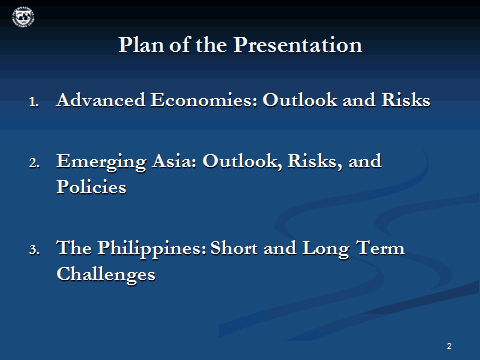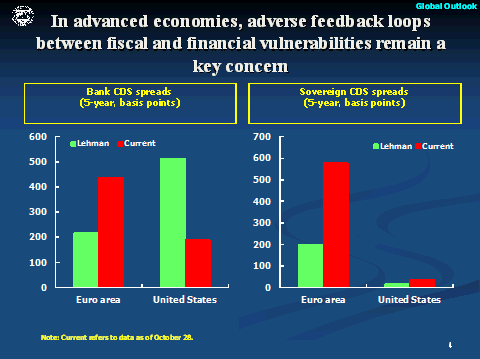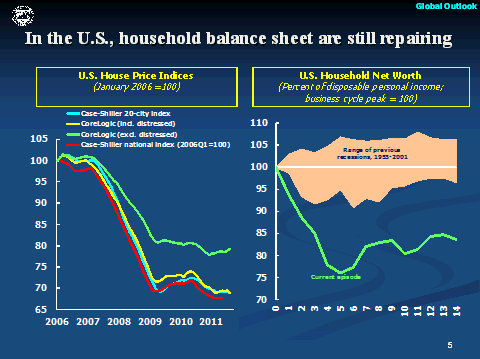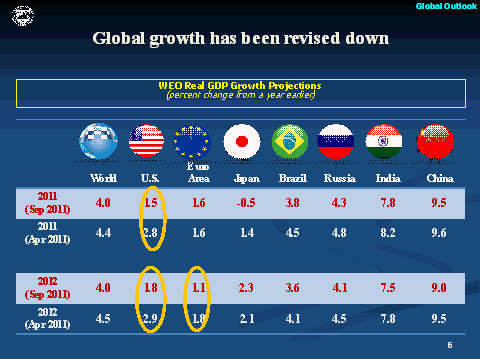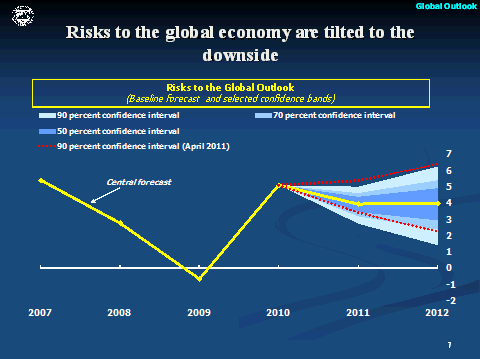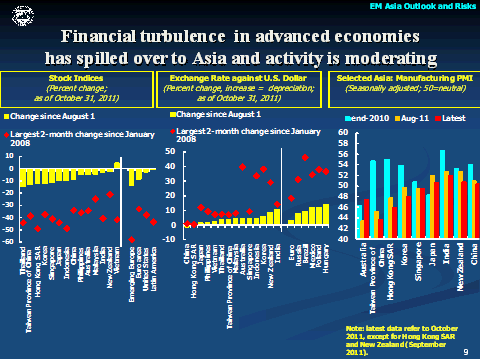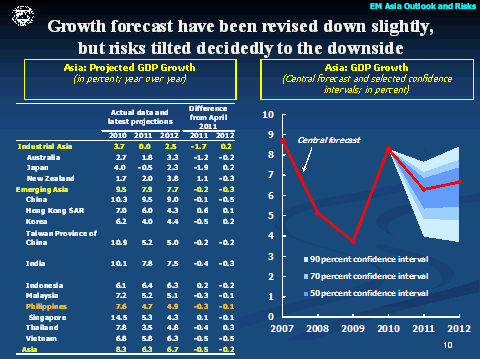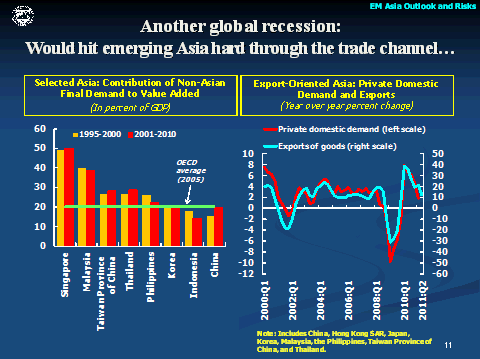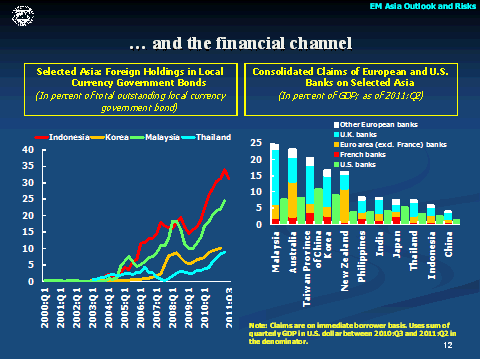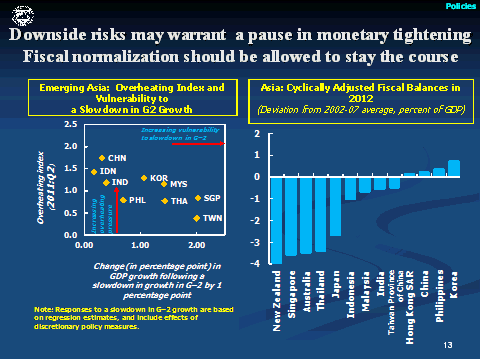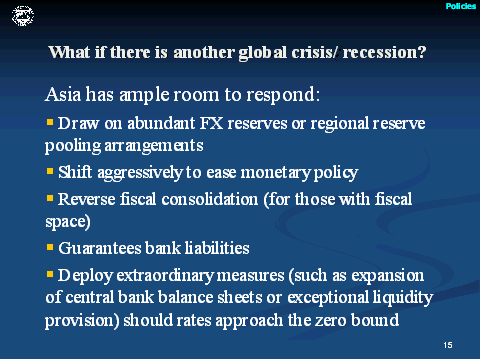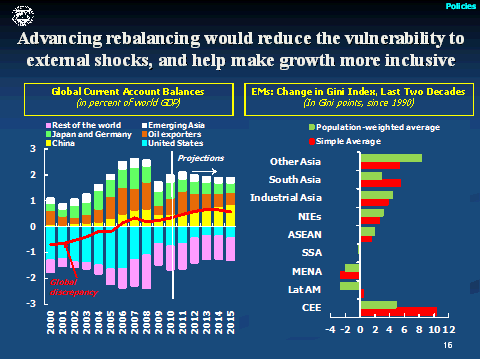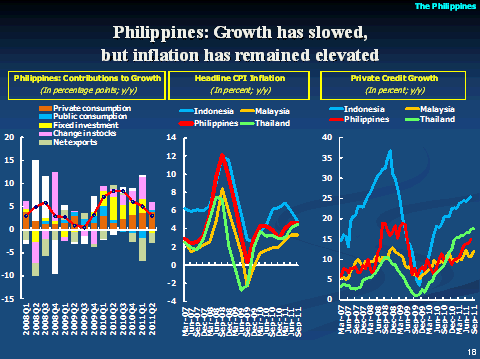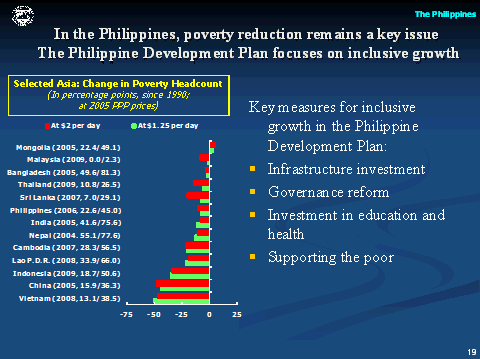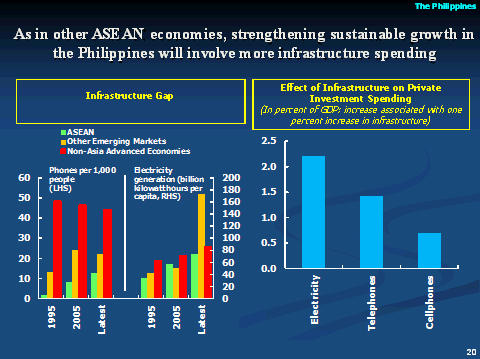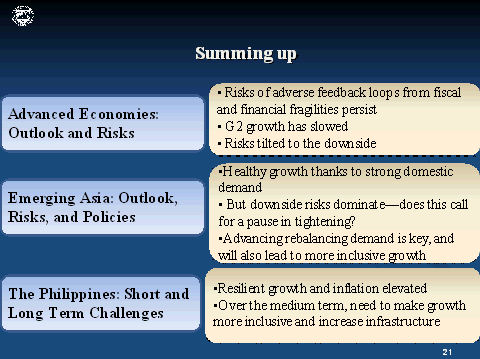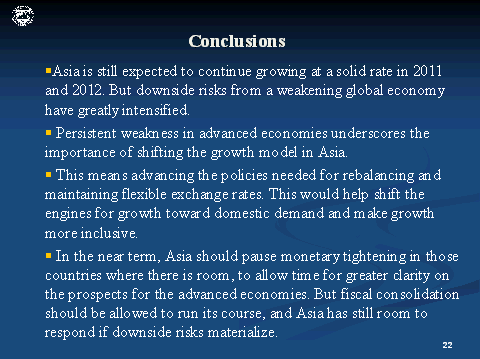Presentation to the Asian Institute of Management by Naoyuki Shinohara, IMF Deputy Managing Director, The Asia-Pacific Economic Outlook and Policy Challenges in an Uncertain Global Environment
November 4, 2011
Naoyuki Shinohara, IMF Deputy Managing Director, International Monetary FundPresentation to the Asian Institute of Management
Manila, November 4, 2011
As prepared for delivery
Good morning. It is a sincere pleasure to be here at the Asian Institute of Management. I would like to thank Mr. Edilberto De Jesus, President of the AIM, for giving me this opportunity to speak to you today.
Plan
Today, I would like to focus on three main themes. First, I would like to briefly discuss our views on the outlook for advanced economies and the risks facing them. Second, I will turn to our assessment of Asia’s economic outlook and the main risks for the region, touching on the main policy challenges that have emerged in Asia against the background of heightened global uncertainty. I will then conclude with a few remarks on the outlook and policy challenges in the Philippines.
What I am about to say can be summarized as follows: The global economy is in a dangerous phase, with a weaker outlook for growth and rising risks. Negative feedback loops between the real economy and the financial sector have arisen. And unemployment in advanced economies remains very high. The perspective is a little different in Asia, but Asia is also vulnerable to the developments in other regions, especially through the trade channel. And emerging Asia is not immune from a risk of financial contagion, either.
Advanced Economies: Outlook and Risks
The Eurozone leaders announced last week a comprehensive package of measures to address the current crisis in that region. This represents a major step in the right direction in several important areas, including a larger haircut on Greek sovereign bonds, a target for bank recapitalization and coordinated term funding facilities, options to leverage the EFSF, and some improvements in EU governance. We welcome these steps. Now the challenge is for this agreement to be fleshed out in detail and implemented.. This is important to restore confidence and reduce risks which have recently risen dramatically.. Indeed, bank CDS spreads, which are hovering around 440 basis points, suggest that risk perceptions concerning European banks are still as bad now as they were for U.S. banks at the time of the Lehman collapse. Furthermore, sovereign CDS spreads for the euro area remain in the neighborhood of 580 basis points, indicating that sovereign risks are perceived as being much worse now than when Lehman collapsed. But perceptions of increased risk are not just limited to Europe. Perceptions of U.S. sovereign risks have also worsened, in part reflecting lack of credible plans for medium-term fiscal consolidation.
In the United States, consumption growth is likely to remain sluggish going forward, as households continue to repair their balance sheets. House prices have been largely stable since 2011Q2, following declines after the expiration of the homebuyer tax credit in mid-2010. Along with equity market losses during the crisis, weak house prices have led to a marked decline in household wealth relative to pre-recession levels. To make things worse, unemployment, currently at 9.1 percent, is expected to remain high through 2012.
Partly reflecting these weaknesses in the US economy, and also the greater uncertainty over the evolution of the euro area crisis and the related spike in financial market volatility, the global recovery has lost steam over the last few months. There has been a marked slowdown in manufacturing activity in advanced economies and forward looking indicators, for example PMI indices, generally point to weaker growth ahead. The September 2011 World Economic Outlook forecasts imply a downward revision to growth since April 2011 in advanced economies of about 0.7 percent of GDP in 2011 and 2012. In particular, U.S. growth has been revised down by almost a full percentage point in 2011 and 2012. Taken together, global growth is expected to continue at 4 percent in 2011 and 2012 largely owing to still robust performance of emerging and developing economies. Nonetheless, it should be noted that growth in advanced countries is expected to remain sluggish, that is, well below pre-crisis rates, particularly in the euro area and the United States.
Of particular importance, it should be emphasized that the risks surrounding these forecasts are markedly tilted to the downside. Moreover, the probability that global growth will be less than 2 percent—a common definition of a “global recession”—in 2012 is now greater than 10 percent. Specifically, the main risk to the global outlook is that the euro area crisis runs beyond the control of policymakers, spilling over to the United States and from there to the rest of the world. The other key risk is that activity in the United States, which is already softening, might suffer further blows—for example, from a political impasse over fiscal consolidation, a weak housing market, rapid increases in household saving rates, or further deterioration in financial conditions.
Emerging Asia: Outlook, Risks, and Policies
Let me now turn my attention to Asia. Financial turbulence in advanced economies has spilled over to the region. In particular, in August and September equity prices plummeted and regional currencies depreciated markedly against the U.S. dollar. Although these declines were not as sharp as in the aftermath of the Lehman Brothers bankruptcy, and financial markets seem to have stabilized somewhat in recent weeks, financial strains remain elevated and have coincided with moderating economic activity. Recent PMI readings, for example, are generally at lower levels than they were six months ago.
In line with the weaker global outlook, and given these recent developments, in our most recent Asia and Pacific Regional Economic Outlook, which we launched here in Manila just a few weeks ago, we revised down our projections for growth in the region in 2011 and 2012 relative to our April Outlook. In particular, for China and India, we now project growth at 9.5 percent and 7.8 percent in 2011, respectively. In 2012, growth is expected to slightly moderate by half a percentage point in these two countries. For China in particular, what we expect is a smooth move toward a soft landing, as the economy continues to grow at an enviable pace: China indeed remains a bright spot of the global economy. Although exuberance in the property market remains a concern, recent measures to cool the property market seem to be having a cooling effect on that market. Among major ASEAN economies, we expect growth to slow only modestly in 2012. In the Philippines, while we expect growth to come down to 4.7 percent in 2011, economic activity is expected to pick up in 2012 percent to 4.9 percent. However, in parallel with global trends, risks to Asia are decidedly tilted to the downside as well. In particular, euro area financial turbulence would cause pressures in other parts of the world, and a slowdown in the United States could spill over to Asia.
The realization of such tail risks would have a particularly strong impact on Asia through the trade channel. Despite the increase in intraregional trade over the last decade, Asia is still highly dependent on external demand to underpin growth, which is especially true for Singapore, Malaysia, and Taiwan Province of China. Furthermore, a potentially sharp slowdown in exports would also exert substantial knock-on effects on domestic demand, mainly through affecting investment in the tradable sector which account for 40 percent of overall investment on average in Emerging Asia.
Financial contagion is also a risk. The panic equity sell-offs across Asia in August and September illustrates the region’s vulnerabilities to further global shocks. An intensification of turmoil in the euro zone could affect Asia through two main channels.
- First, since the mid 2000s, investors from advanced countries have built up substantial positions in Asian markets, including in sovereign debt markets. A sudden liquidation of these positions could cause severe financial turbulence, and the loss of confidence may lead to contagion to other asset markets.
- Second, contagion could be transmitted through foreign banks, which may not rollover loans and cut credit lines to Asia if faced with large losses at home. Asia is particularly exposed to further troubles in European banks, as they have relatively greater exposure to the region than US banks and are important providers of U.S. dollar funding to the region.
What does the outlook mean for policies in Emerging Asia? Is a pause in policy tightening warranted against the backdrop of the unusual uncertainty on the economic outlook? Starting with monetary policy, the room for pausing varies across countries. Specifically, for economies where overheating pressures are more muted and global financial linkages greater, a pause in monetary tightening may be warranted. By contrast, in economies where overheating remains more elevated and the sensitivity to global demand is relatively smaller, there is less room for pausing the tightening cycle. It is also important to underscore that Asian policymakers need to remain vigilant regarding balance sheet vulnerabilities. Since maintaining accommodative financial conditions for an extended period could fuel further credit expansion and result in lower asset quality, monetary tightening would need to resume once the uncertainty over the global outlook is reduced. Turning to fiscal policy, the return of fiscal balances to a more neutral position should continue. Under current staff projections, fiscal positions are expected to remain accommodative in 2012 in many Asian economies, as indicated by the cyclically adjusted government balances. In the Philippines, the government has started to withdraw the stimulus that was put in place during the crisis and its medium term plans to reduce the deficit to 2 percent of GDP by 2013 are appropriate. Fiscal consolidation is needed in order to build up fiscal space to deal with potential future shocks, including natural disasters, as well as to help meet the country’s pressing social and infrastructure needs.
Further upward exchange rate flexibility would increase the room for a pause in the interest rate tightening cycle, as it would help contain remaining inflationary pressures, and would also contribute to rebalance growth in Asia, a key medium-term policy priority that I will turn to next. Several Asian currencies remain below their levels during the early 1990s in real effective terms, suggesting there is room for further upward movement. The peso, however, remains broadly in line with medium term fundamentals. In general, Asian currencies have appreciated much less than in other regions, as upward pressures have been accommodated by building up foreign exchange reserves. One measure of reserve cover is the ratio of foreign exchange reserves scaled by short-term external debt. Based on this metric, a prudent reserve cover level—which should be interpreted as an indicative guide—is typically 100 percent. In Asia, the reserves cover is much greater than in other regions and seems adequate to protect the region from external shocks. For example, the average reserve cover across Indonesia, Malaysia, Thailand, Vietnam, and the Philippines exceeds 275 percent.
Should the downside risks to the outlook materialize, policymakers in Asia would need to respond swiftly, as they did during the global financial crisis of 2008–09. Luckily Asia’s fundamentals are relatively good, and the scope for policy adjustments is much greater than in other regions of the world. Macroeconomic policies would have to reverse gears, with monetary policy shifting to easing and fiscal policy stimulating activity in countries with fiscal space. Many economies can draw on the large accumulated foreign exchange reserves or utilize regional reserve pooling arrangements to avoid contagion through a collapse of currencies as foreign investors liquidate positions in local markets. Finally, as in 2008–09, policymakers can revert to extraordinary measures to ensure financial stability, such as providing public capital to financial institutions and introducing government guarantees on their liabilities.
The weakness in global demand only confirms that Asia would greatly benefit from rapid progress in rebalancing growth towards domestic sources of demand. While global imbalances narrowed during the global financial crisis of 2008–09, they are projected to re-emerge over the medium term as the structural factors behind them remain un-tackled. In particular, we expect the contribution from Emerging Asia to increase over time, although mostly from China, where the consumption share of GDP continues to be on a downward trend. Another medium-term policy priority is to make growth more equitable and durable. Income inequality has risen in Asia in the last two decades, despite rapid economic growth and notable progress in reducing poverty. A commonly used measure of income inequality is the Gini coefficient, where a value of 0 expresses total equality, and a value of 1 maximal inequality. The Gini coefficient has increased in the region, indicating rising income inequality in Asia, in contrast to Latin America, the Middle East and North Africa. It is important to stress that inclusive growth and economic rebalancing are two sides of the same coin, as measures that stem inequality—for example, better social safety nets—can also serve to strengthen domestic demand. In particular, public spending on health and education in most Asian economies falls short of levels in countries at similar levels of development, demographics, economic structure, and urbanization, even after accounting for factors such as different quality of spending. Re-prioritizing fiscal spending towards these chapters could be an important component of an effort to make growth in Asia more inclusive and less reliant on external demand.
The Philippines: Short- and Long-Term Challenges
Turning now to the Philippines, GDP growth slowed in the first half of 2011, owing to lower export growth and a temporary dip in public expenditure. At the same time, inflation has been elevated, but its momentum has softened in recent months and inflation expectations have been coming down. Amid heightened global uncertainties and moderating inflation pressure, monetary tightening seems to have paused (as it has done in several other Asian countries as well). Credit growth is rapid, however, and needs to be carefully monitored to avoid a build-up of balance-sheet vulnerabilities. Fiscal policy, meanwhile, continues to be consolidated, which will help to build up policy space to respond to future shocks as well as help address the country’s infrastructure and social safety-net needs.
A stronger social safety net and higher growth are both needed in order to build inclusive development. Some poverty reduction has been achieved in the Philippines in recent decades, but poverty and inequality remain high. The Medium-Term Philippine Development Plan for 2011–2016 focuses on making growth more inclusive including through increasing infrastructure investment, improving governance, investing in education and health, and supporting the poor through, for example, conditional cash transfers and better access to credit. Achieving these objectives will require a strengthening of government revenues, including by broadening the tax base, and strengthening tax administration and collection.
Finally, building stronger growth in the Philippines, and in other ASEAN economies, would involve more infrastructure spending. Infrastructure in the region has improved since the 1990s, but still lags other emerging markets regions. For example, the median electricity-generating capacity in the ASEAN is approximately 42 percent of the median for other emerging markets. Also, despite the rapid spread of telephones, particularly mobile phones, in the past decade, ASEAN economies also continue to lag behind other emerging markets in their stock of telecommunications infrastructure. Importantly, estimates based on a model built by staff show that higher infrastructure spending—especially in electricity—could crowd private investment in, thereby raising ASEAN potential growth.
Conclusions
In my concluding remarks, I would like to emphasize some key policy challenges against the current background of heightened global uncertainty.
- The Eurozone leaders have taken steps toward addressing the crisis in their countries, but important details still need to be elaborated and implementation will be key. Until then the risks of adverse feedback loops from deteriorating global economic and financial conditions will remain very real. Policymakers must build on recent positive progress in Europe to decisively forestall a downward spiral of unsustainable debt dynamics, dysfunctional financial markets, falling demand, and rising unemployment. At the same time, in the US, important policy steps are needed to repair household balance sheet, which is key to that country’s full economic recovery.
- The main challenges for Asian policymakers going forward are to support activity in a fragile global setting, while ensuring that growth is of the right “quality”. The renewed weakness in advanced countries highlights the need to rebalance to reduce vulnerability. Policies to do so will also lead to more equitable growth.
- In the near term, against the backdrop of unusual uncertainty, a pause in the pace of tightening may be warranted in countries where inflation, and more generally, overhearing pressures are under control. Allowing stronger exchange rates would give more room to monetary policy to pause, as it would help contain remaining inflationary pressures, but would also help rebalancing growth by sustaining domestic demand.
Thank you for your attention.
IMF EXTERNAL RELATIONS DEPARTMENT
| Public Affairs | Media Relations | |||
|---|---|---|---|---|
| E-mail: | publicaffairs@imf.org | E-mail: | media@imf.org | |
| Fax: | 202-623-6220 | Phone: | 202-623-7100 | |








